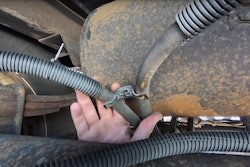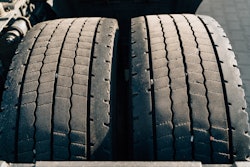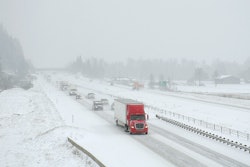Larger fleets typically have more access than smaller carriers to programs that offer lower prices, improved service and more. Tire manufacturer Bridgestone is launching a new program, however, that aims to help smaller fleets in the last-mile segment save on tires.
The new Bridgestone Last Mile Tire System will be fully managed by Bridgestone, with the company owning all of the tires and keeping track of tread depth, allowing fleets to get the most use out of their tires before replacement.
Jason and Matt are joined this week by Christine Reagan, Director of Last Mile Solutions at Bridgestone, who talks about the benefits of the program and how it will help fleets stay on top of their tire management programs.
Contents of this video
00:00 Bridgestone’s Last Mile Tire System
02:38 Experience and new technology
03:48 Fully managed tire program for small and medium fleets
07:24 Benefits of the Last Mile Tire System
08:27 Tracking tire wear
09:33 Program launch schedule
10:42 Pricing of tires
Jason Cannon:
This week's 10-44 is brought to you by Chevron Delo 600 ADF Ultra Low Ash Diesel Engine Oil. It's time to Kick Some Ash.
Matt Cole:
How Bridgestone is re-imagining Tire Management programs for small and medium sized last mile fleets.
Jason Cannon:
Hey everybody, happy New Year's Eve eve, and welcome back to the 10-44, a weekly webisode from the editors here at CCJ. I'm Jason Cannon, and my co-host on the other side, is Matt Cole. Larger fleets and trucking generally have more access to programs that offer lower prices, improved service and other things. Tire manufacturer, Bridgestone, is looking to help smaller fleets in the last mile segment with the introduction of a new tire management program.
Matt Cole:
Bridgestone's Last Mile Tire System allows small and medium sized fleets to manage their tires while unlocking the benefits that Jason mentioned, traditionally only enjoyed by large fleets. We're joined by Christine Reagan, director of Last Mile Solutions at Bridgestone, who talks about the company's new program and how it aims to help tire management for smaller or last mile fleets.
Christine Reagan:
Last mile, I think, is a term that all of us have been using forever, and then most of the time we associate it with Amazon or FedEx delivery. So it come into a house, but it's definitely more that, that's been growing for a while. I think through the pandemic, we've seen it significantly continue to increase here in North America, and as we look into the future as well, is going to be a market that continues to grow at somewhere around 27% over the next five years. So it's a high interest for us.
We do play strongly in that market today with larger fleets, but the majority of these fleets, even if we're thinking about FedEx and Amazon and those companies, it's small and medium fleets that operate on behalf of those larger organizations. And historically, these fleets have two issues. One, they're very cash constrained, and so when they're operating, when it comes to what is the right tires, which is what we care about, what are the right tires that I should be buying for our operation, they tend to err on the side of what's the tire that I can't afford right now, just to keep afloat and operate, versus what is really the right tire that I should be buying.
And so, that means we have lower market share than we'd like to have. It's a growing market segment, so it's definitely interesting for us. The other key thing is, as we're transitioning to become a sustainable solutions provider, again, these fleets purchase tires that aren't really set up to be retreaded, to be used in the right ways. And most of the time it's a one and done situations, where a lot of these tires that don't last long, in some cases one month, three months, four months, and that just end up in landfills. And it's so a very wasteful application, and we believe that we have a better way of helping those fleets, helping the larger organizations and really see all around benefit.
Jason Cannon:
Christine says Bridgestone is using its experience from its existing tire management programs, and coupling that with new technology in this program.
Christine Reagan:
We've been looking at this market and looking at fleets and learning about the segment for probably on a more focused level the last two years specifically. We were lucky enough to connect with someone in this space that has a strong interest in managing the tire program better, and we obviously have a lot of learnings from our larger fleet and national account programs. So if you're thinking about the Penske's, the UPSs, the J.B. Hunt of this world, there's a lot of things that we're already doing with larger fleets that helped us carry over into this smaller fleet space.
In addition to that, as we go through life, technology improves, and we've been testing different technology options that really drive enablement of the program, and we'll talk about that here in a little bit, but it's all about, how can I make this more efficient for all the different parties involved. And so we were testing, for example, some drive-over readers, and all of that accumulated together about a year and a half ago. And so, we started setting out on some pilots with some very specific fleets, just a handful to see how the program works. And to your point now, we're getting ready to kick it off next year on a broader scale.
Matt Cole:
The new program will be a fully managed tire program for small and medium fleets with Bridgestone owning the tires and continuously monitoring tire health to optimize replacement. Fleets in the program will be charged not only per tire basis, but rather based on usage.
Christine Reagan:
So a program that we've developed, we call it our Last Mile Tire System, and really what it is, it's a fully managed tire program for these small and medium fleets. Right now, we're focusing on fleets that are domiciled, so meaning fleets that come back to a certain yard, parking lot, terminal, on a somewhat frequent basis, because the whole concept is the assets. The tires on the vehicles are our assets that Bridgestone will own and manage. We will track them throughout the use, and optimize the replacements of those tires through our commercial dealer network. And then we will turn around and charge the fleet, not on a per-tire basis, like we talked about them being very cash constrained and we're still going to be using the most premium and optimized tires for this application, but by being able to track the usage, aka the use of the tread depths of the tire or the loss of the tread depths.
We're consolidating that usage at the end of the month for the fleet, so they only pay for what they use. So it's more as a pay-as-you-go program. So in more detail, how the program really works is, we work with a fleet. We go in, we pretty much buy them out of their tires, so we take over all those assets, and from that point on, we start tracking them. Right now, on a weekly basis. In the future, if we have these drive-over systems on a more broader scale out in the market, really every time they come back to their terminal or their yard, we get those measurements, and that allows us to then take that information and notify our dealer network when a tire needs to be replaced.
So we can be very specific that vehicle 123, the front right tire is at five, 30 seconds, DOT is four. So we want to go out that week, check the tire, make sure that it gets replaced at the right time. The dealer manages all of that in-yard, after hours, so the fleet doesn't have to take their vehicle somewhere, their drivers don't have to go and drop them off or get a replacement vehicle for the time while the vehicle's in the shop.
And then we take those tires back, we evaluate them. If we can retread them, if we can, then we reintroduce retreads into the program as well. Again, to drive that sustainability factor, and Bridgestone manages all of that piece with our commercial dealer network. We then share that information with the fleets, and as I mentioned earlier, charged them on a pay-as-you-go basis.
Jason Cannon:
After a word from 10-44 sponsor, Chevron Lubricants, we'll hear more from Christine about the benefits of the Last Mile Tire System.
Protecting your diesel engine and its after treatment system has traditionally been a double-edged sword. The same engine oil that is so essential to protecting your engine's internal parts, is also responsible for 90% of the ash that is clogging up your DPF and upping your fuel and maintenance costs. Outdated industry thinking still sees a trade-off between engine and emission system protection, and Chevron was tired of it, so they spent a decade of R&D, developing a no compromise formulation.
Chevron Lubricants developed a new ultra low ash diesel engine oil that is specifically designed to combat DPF ash clogging. Delo 600 ADF with OMNIMAX technology cut sulfate ash by a whopping 60%, which reduces the rate of DPF clogging and extends DPF service life by two and a half times. And just think what you can do with all the MPGs you're going to add from cutting your number of regions. But Delo 600 ADF isn't just about after treatment. It provides complete protection, extending drain intervals by preventing oil breakdown. Before, you had to choose between protecting your engine or your after treatment system, and now you don't. 600 ADF from Delo with OMNIMAX technology, it's time to Kick Some Ash.
Christine Reagan:
So the overall benefits are at a multitude. I would say for the fleets, first and foremost, it's about ease of mind and convenience. Tires isn't necessarily what they want to spend most of their time on, but they've run through tires very, very quickly. And so, it tends to be a key downtime point for them. So not having to think about when tires need to be replaced, making sure that they only pay for the tires that, or what they use of that tire, is key. Today, you might go in for an oil change, and if a dealer notices, "Hey, this tire is at six, 30 seconds", they're probably going to recommend that you change that tire.
So in this case, if it's a steer tire, you're going to lose two, 30 seconds of the value that you paid for that tire. The dealer makes money, and the fleet sits there and ends up having a pretty high bill. So it's about really just paying for what they use, having that cashflow benefit of paying for that 32nd usage, and not for the whole tire at one point in time, and that ease of mind on the convenience and the compliance basis, although while they get to use the most premium products in that application.
Matt Cole:
To track tire wear, Bridgestone has invested in a company with a drive-over system that measures the tread depth of a trucks' tires as it drives over the sensors.
Christine Reagan:
We're working with a company that we've invested into that has a great drive-over system, so think of it as a little speed bump that would be installed in the yard and it measures through magnetic waves, the distance between the mat that you drive-over and the steel belts in the tire. And so, therefore we get a really good accurate reading of what the actual tread depths of each of the tires are. So instead of having a person go out every week or every day, measure those tires, which is not very efficient and not a fun job, we actually get that data automatically, that as you mentioned, enables all of that.
Currently, we're starting to roll out these mats. The program works with manual measurements, and most cases a weekly measurement is completely sufficient, depending on the application. If you have some over the road fleets, tires last one to two years, so you don't need to measure daily certainly, but as you get closer to that pool point, the more data points you have, the higher the accuracy. We want to make sure we have compliant vehicles on the road, safe operating conditions, but also drive efficiency in the program.
Jason Cannon:
The program set the loss with FedEx contractors in early 2023, before a broader rollout in late 2023 and into 2024.
Christine Reagan:
Right now, I think the restrictions is more on us being able to roll out the program in getting there enough. So we have a lot of interest, but right now, we're restricting it more to some key metros, building through that next year. And then a much broader rollout into second half of '23 into '24. So we've focused specifically right now on the rollout within the FedEx contractor space. And so, we have a list of interest more than we can handle.
So really, it's more about a direct contact relationship and reach out. So we have an email, it's [email protected], and we can also share a website link that talks about the program. So if there's any interest, fleets can reach out through either the website or that email, to let us know if they're interested, and then we'll work through likely follow-up discussions calls, and then figure out where they fit in the priority plan. We're also working on some interim programs that fleets can use if we can't get them into the fully managed program, so that they do get access to premium tires at better pricing that they would get retail today, but it's more on a direct communication path right now.
Matt Cole:
Christine says the pricing will be based on tire size, then broken down to a price per 30 seconds of tread depth.
Christine Reagan:
On the pricing side, we try to make it simple, just because it can get very complex. Pretty much we agree upfront. We have a recommended portfolio of products that we want to use, which are specifically designed in this case for pickup and delivery, high scrub, stop and go type of application. If you are more of a line haul contractor, more regional application, we have products for that as well. And then the largest tire sizes in terms of category would be 16 inch, 19 and a half inch, 22 and 24 and a half inch tires. So instead of breaking it down by product, we said, "Okay, here's a price per tire size, so let's pick a 19 and a half inch tire. Here's the price per 30 seconds that you would pay, and that's an all-inclusive price." So that price per 32nd includes obviously the tire itself, broken down, but it also includes the cost for us to track your tire from a tread depths measurement standpoint, whether that's manually or via technology.
It's the in yard service that our dealers would provide to you, the installs, the mountain dismount, any balancing costs, if your valve stem needs to be replaced, all of the other environmental disposal fees, all the other things that you normally see on your tire invoice, all of that is included in that specific cost per 32nd. And so, it's very easy to track. If you want to do the math for yourself, it would have to be an average of, again, here's your steel tires, here's your drive tires. But instead of breaking all that out, we try to keep it simple. So it's one price for 30 seconds for each of the different tire sizes.
Jason Cannon:
That's it for this week's 10-44. You can read more on ccjdigital.com. As always, you can find the 10-44 each week on CCJ's YouTube channel. And if you've got questions, comments, criticisms or feedback, please hit us up at [email protected] or give us a call at 404-491-1380. Until next week, everybody have a safe new year, and be safe out on the road.










